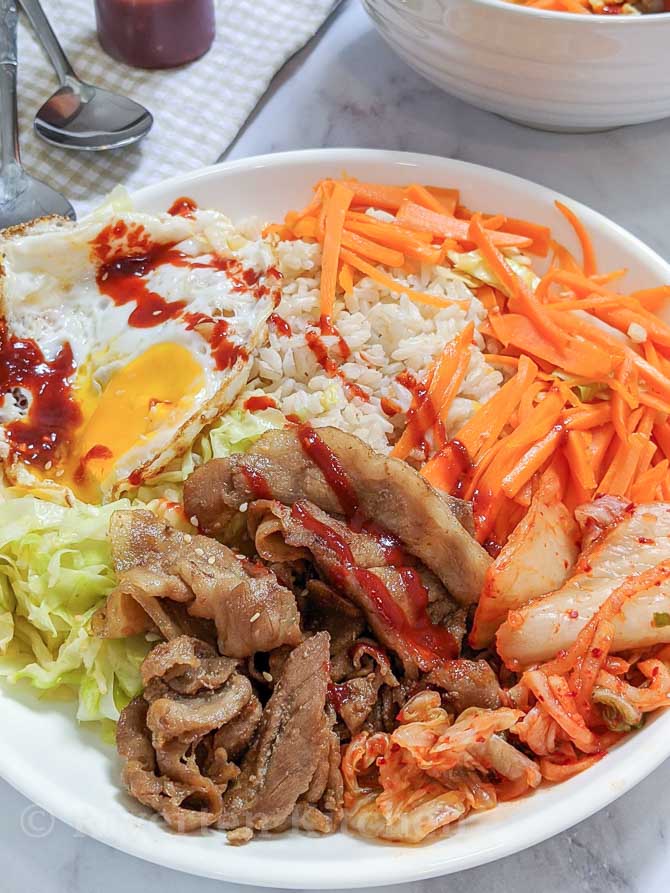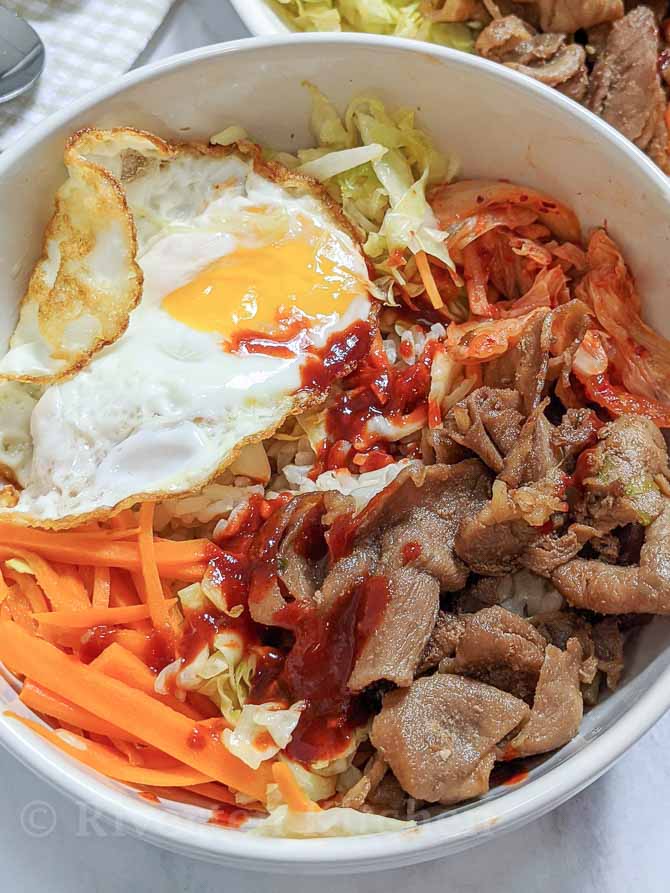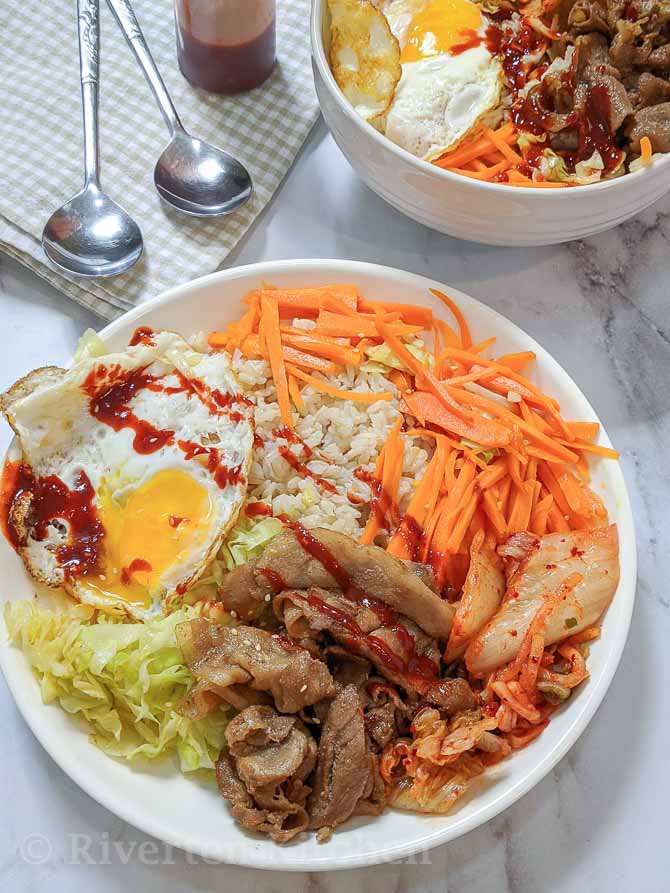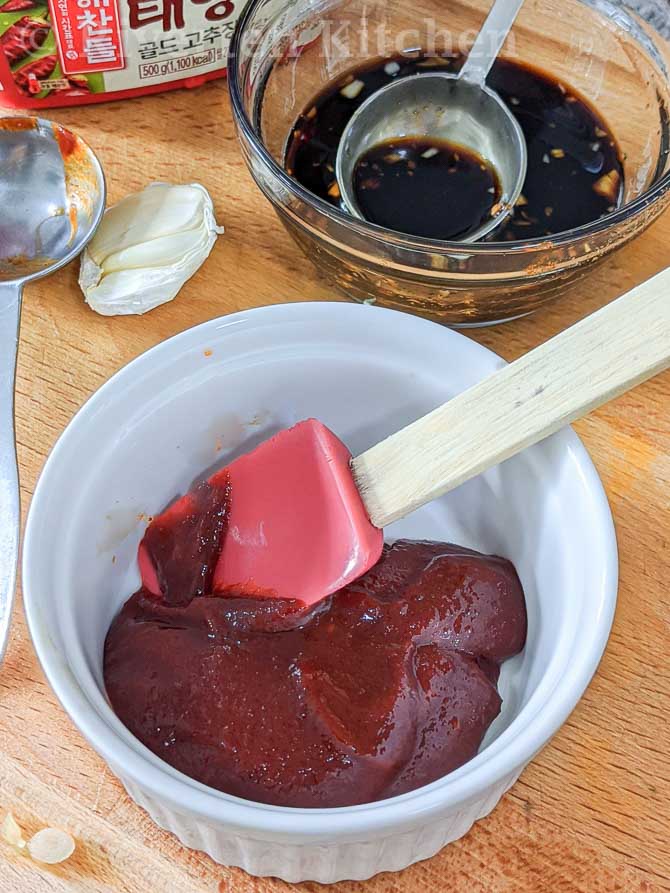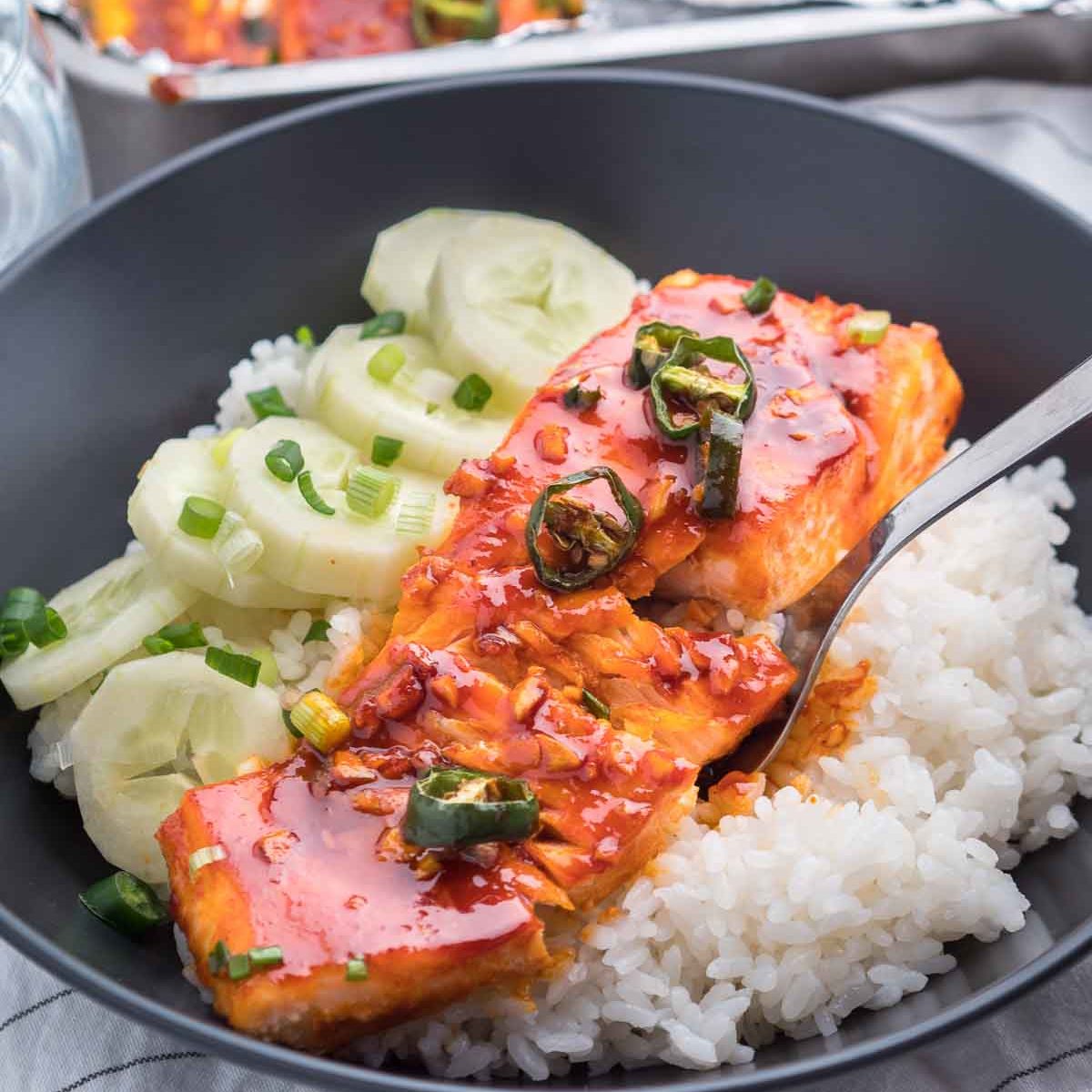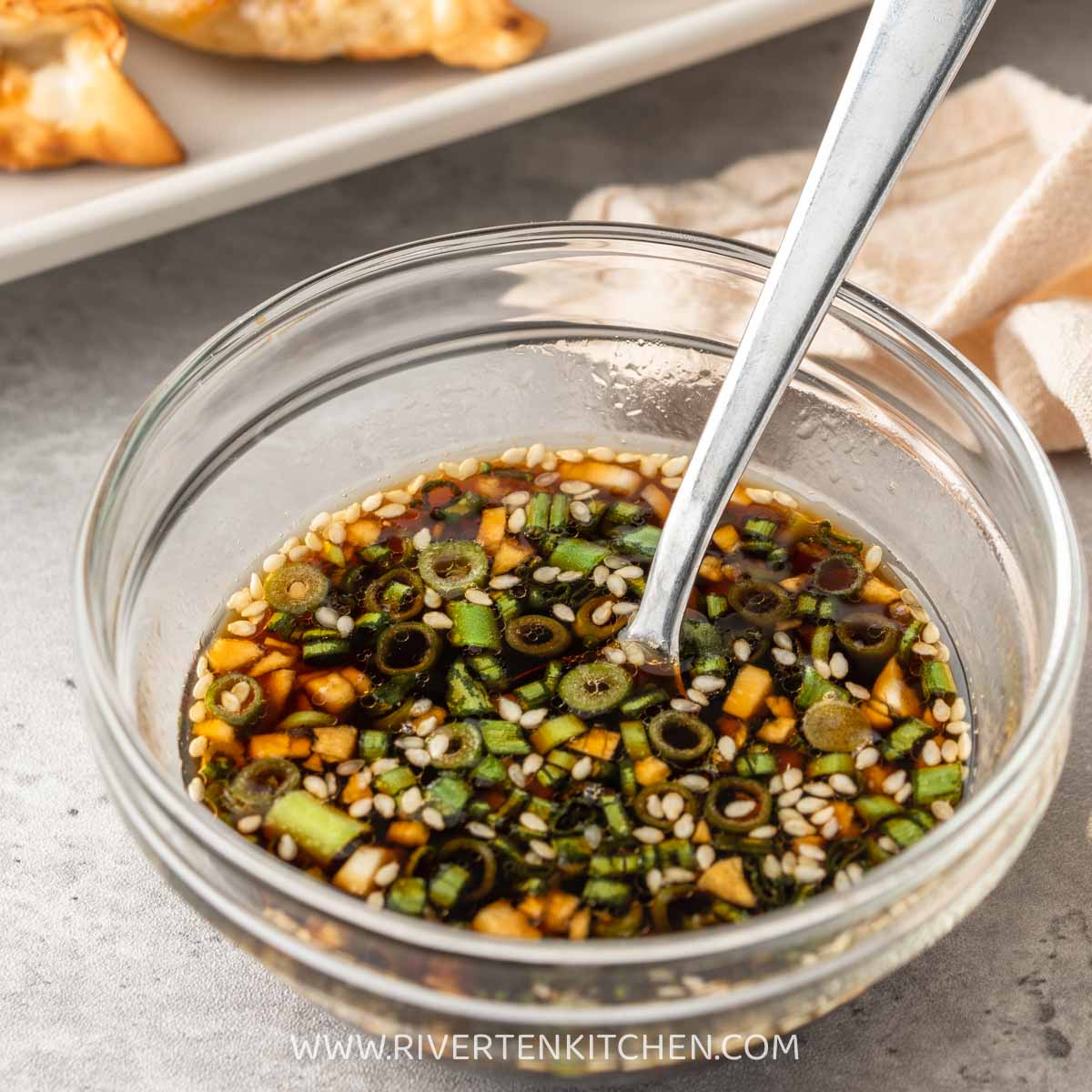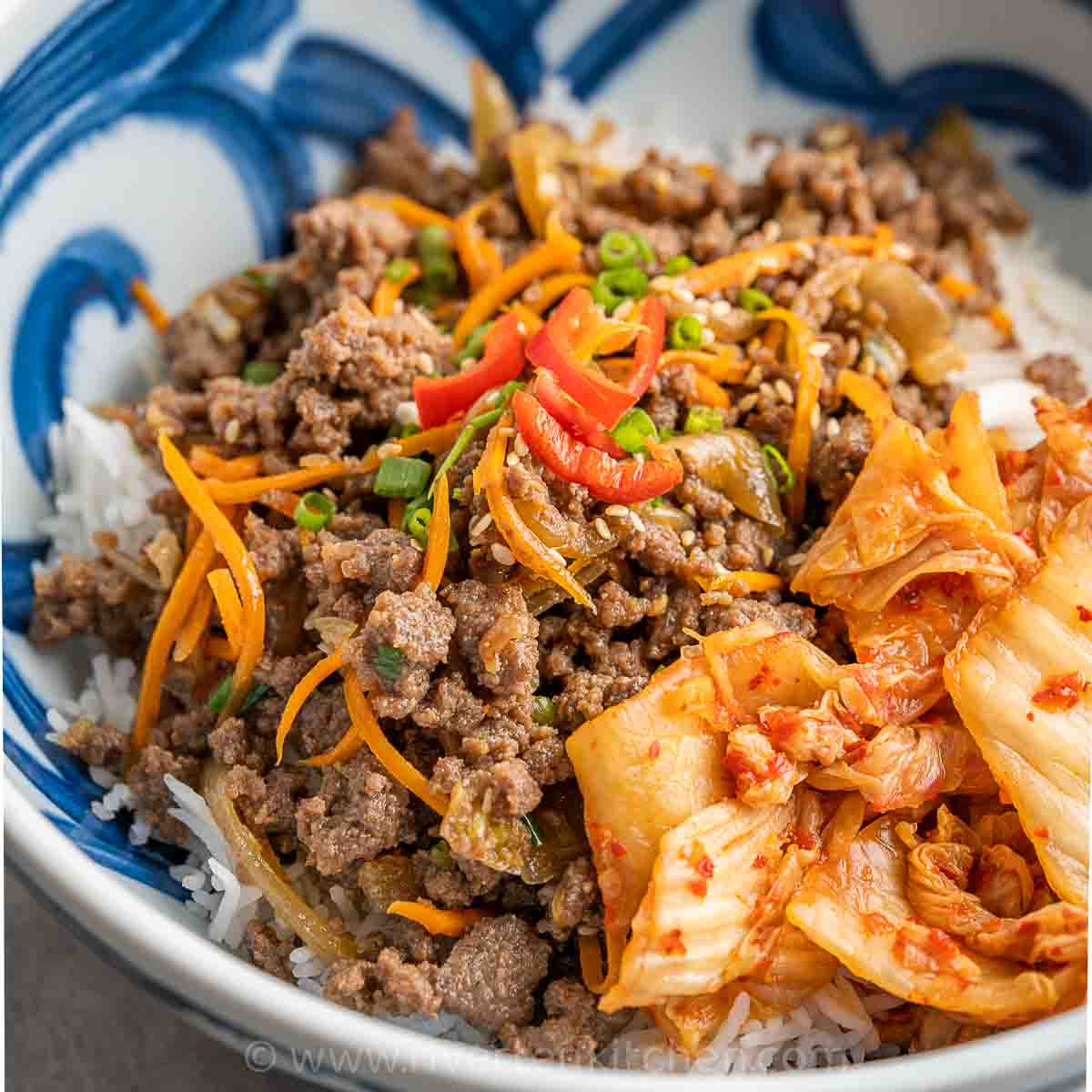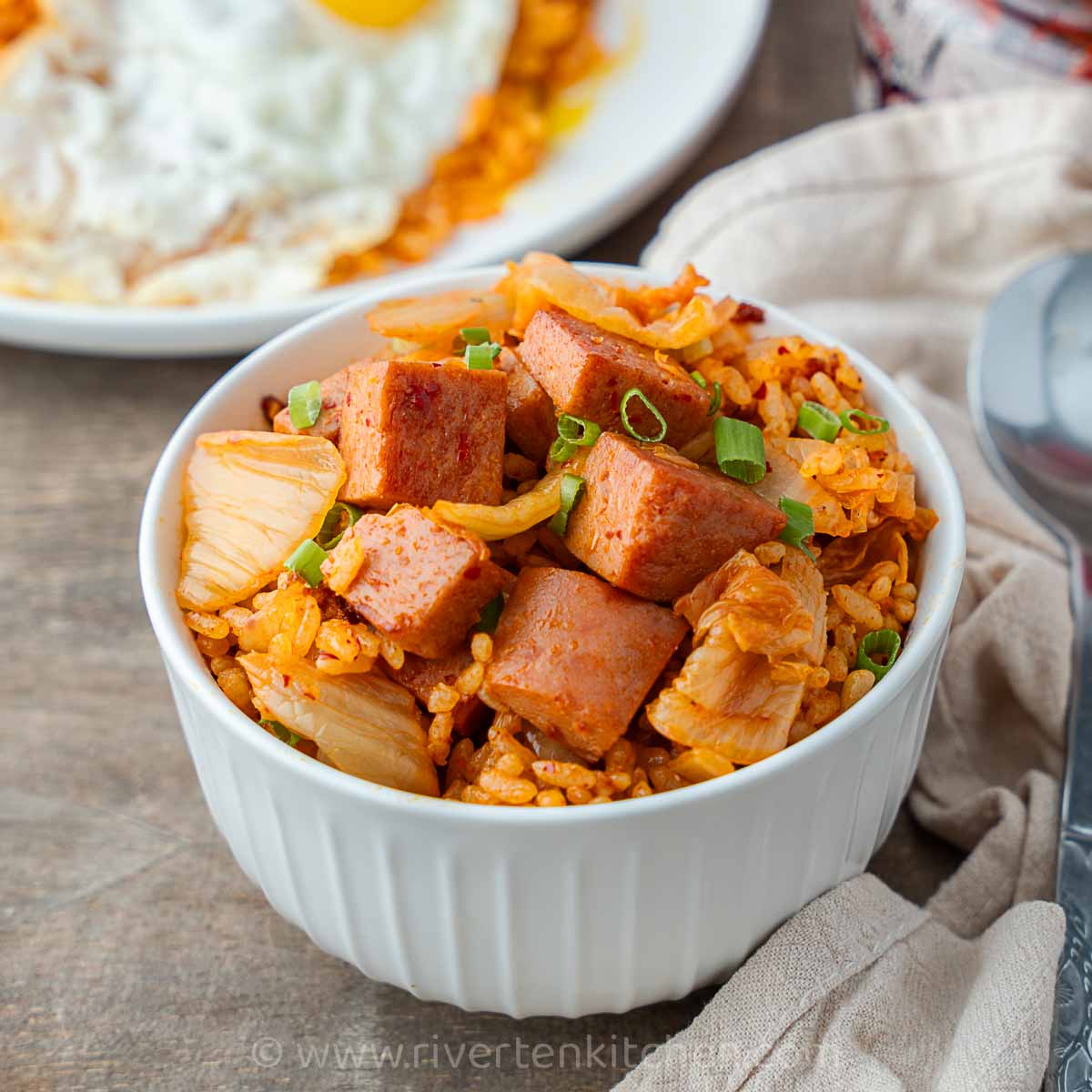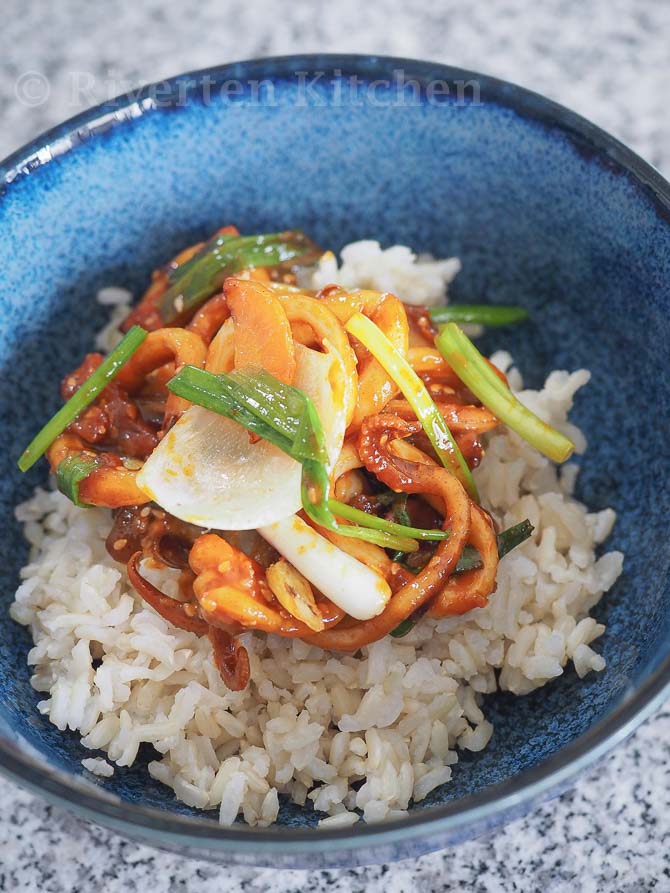This is the easiest bibimbap recipe you’ll ever make. Perfect for sudden Korean food cravings! It involves minimal preparation and uses just a handful of ingredients. Customize it based on whatever vegetables or meat you have–thinly sliced meat, ground pork or beef; use spam and other deli meats for convenience. You can even make it vegetarian!
What is Bibimbap?
Bibimbap is one of my favorite Korean dishes. It is made of assorted ingredients cooked separately then mixed together in a bowl with rice. “The term “bibim” means mixing various ingredients, while the “bap” refers to rice (source).
To make it you will need:
- Rice – use white Jasmine rice or brown rice but I find it most enjoyable with short-grain rice i.e. Japanese rice.
- Vegetable toppings – Bibimbap is an easily customizable dish and you can probably use most vegetables in. In this recipe, I only used two vegetables–cabbage and carrots.
- Egg – sunny side up or scrambled eggs.
- Meat – use what you have at hand–pork, beef, chicken, or even salmon.
- Bibimbap Sauce – you can easily make this at home. Recipe below.
Quick and easy Korean Bibimbap: How to make it
Here’s how this goes down:
- cook the rice
- prepare the meat and slice the vegetables. I recommend limiting to 2 to 3 kinds of veggies for easier prep.
- make the Bibimbap sauce and meat marinade (bulgogi sauce).
- fry the eggs.
- stir-fry the vegetables separately in sesame oil with minced garlic if preferred.
- cook the meat with the marinade.
- assemble everything in the bowl then drizzle bibimbap sauce all over then MIX! MIX MIX!
What are the recommended vegetable toppings for Bibimbap?
Here’s a list of my favorite vegetables for Bibimbap, including notes on how I usually prepare it.
- kimchi
- mung bean sprouts – rinse in cold water; blanch in boiling water or stir-fry
- zucchini/courgette – cut 1/4 inch thick half-moons, stir-fry to cook
- cabbage/ napa cabbage – shredded, stir-fry to cook
- carrots – peel then shredded, stir-fry until tender-crisp
- radish – peel then slice into thin strips, stir-fry or blanch
- cucumber – cut 1/4 inch thick half-moons; eat raw or stir-fry
- spinach – any variety; stir-fry
- lettuce – eat raw or stir-fry
- bok choy/pak choi – thinly sliced then stir-fry
How to make the Bibimbap sauce?
To make Bibimbap sauce, you will need:
- 3 tbsp gochujang – the base of bibimbap sauce
- 1-2 tsp of the bulgogi sauce – the same marinade I used for the meat
- 1 tsp sesame oil
- 2 tbsp hot water – this will help thin out the sauce; add more if needed
Place all ingredients in a bowl. Stir until well combined. This recipe makes 2 servings.
What is the best meat for easy and quick bibimbap?
- Thinly sliced tender cuts of pork or beef. Have your butcher cut it for you for convenience. In this recipe, I used half a packed of shabu-shabu pork belly meat.
- Diced chicken breast or boneless chicken thighs.
- Ground pork or beef are both also good options. No slicing needed
- Using packed pre-sliced meat such as stir-fry or sukiyaki cut will also make prep easier.
- Spam, ham and sausage/ hotdogs or any deli cuts
Can I make Korean bibimbap without meat?
Yes, most definitely. You can omit protein entirely or substitute with a vegetarian option like fried tofu or mushrooms.
Love Asian flavors? Try these recipes!
- Salmon Teriyaki Fried Rice
- Thai Basil Beef Zucchini Stir-fry
- Quick and Easy Beef Stir-fry
- Sweet and Sour Whole Fish
- Misua Soup with Sesame Pork Meatballs
- Sweet and Sour Chicken with Pineapple
- Pork Fried Rice
- Quick and Easy Korean Beef Bulgogi
- Filipino Lumpia (Fried Spring Rolls)
- Sweet and Sour Whole Fish
- Ground Pork and Green Bean Stir fry
- Brown Fried Rice with Chinese Sausage
Watch the video on how to make the easiest Korean Bibimbap
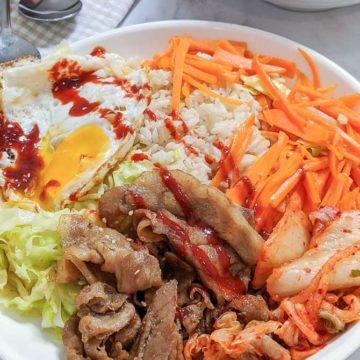
Emergency Korean Bibimbap
Ingredients
- 2 cups cooked rice
- 150 grams - 200 grams sliced meat (see notes for options)
- 2 tbsp cooking oil (divided)
- 2 tbsp sesame oil (divided)
- choice of vegetables (see notes for prep details)
- chopped garlic (for stir-frying)
- 2 large eggs
- kimchi (optional)
Bulgogi Sauce (for the meat)
- 3 tbsp light soy sauce (or 2 tbsp regular soy sauce)
- 3 tsp sugar (add more if preferred)
- 2 tsp minced garlic
- 1 tsp mirin (optional)
Bibimbap Sauce
- 3 tbsp gochujang paste
- 2 tsp bulgogi sauce
- 1 tsp sesame oil
- 2 tbsp hot water (add more if needed)
Instructions
- Cook the rice. Prepare the meat and slice the vegetables.
Make the sauce and Marinade
- Place all ingredients of the bulgogi sauce in a bowl. Stir until sugar is dissolved. Taste and adjust sugar as needed.
- Place all ingredients of the bibimbap sauce in another separate bowl. Stir vigorously until well combined. Taste and adjust sugar/ hot water as needed.
Cook the toppings
- Lightly coat a non-stick pan with cooking oil. Crack the eggs into the pan. Cook until the tops of the whites are set but the yolk is still runny. Set aside.
- In the same pan over med to high heat, add 1 tsp sesame oil. Add 1/4 tsp garlic and carrots. Cook for 1 to 2 minutes just until tender but still crisp. Season with salt. Repeat the same steps for the cabbage or choice of vegetables (see notes). Adjust cooking time depending on the type of vegetable. Set aside.
- In the same pan, heat 1 tbsp cooking oil. Add the sliced meat and remaining meat marinade. Add more garlic if preferred. Stir-fry until the meat is cooked through. Adjust cooking time depending on the type of meat.
Assembly
- Place a serving of rice in a big bowl. Nicely arrange a small amount of each prepared vegetable and meat over the rice. Top with an egg, drizzle with sesame oil and serve with the sauce.
Recipe Notes & Tips:
Rice
- White Jasmine rice or brown rice but I find it most enjoyable with short-grain rice i.e. Japanese rice.
Meat/Protein Options
- Thinly sliced tender cuts of pork or beef. Have your butcher cut it for you for convenience.
- Diced chicken breast or boneless chicken thighs.
- Ground pork or beef
- Packed pre-sliced meat such as stir-fry cut will also make prep easier.
- Spam, ham and sausage/ hotdogs or any deli meat
Recommended vegetable toppings for Bibimbap (use 2 to 3 for easier prep)
- kimchi
- mung bean sprouts - rinse in cold water; blanch in boiling water or stir-fry
- zucchini/courgette - cut 1/4 inch thick half-moons, stir-fry to cook
- cabbage/ napa cabbage - shredded, stir-fry to cook
- carrots - peel then shredded, stir-fry until tender-crisp
- radish - peel then slice into thin strips; blanch or stir-fry
- cucumber - cut 1/4 inch thick half-moons; eat raw or stir-fry
- spinach - any variety; stir-fry
- lettuce - eat raw or stir-fry
- bok choy/pak choi - thinly sliced then stir-fry
If using spam or cold cuts:
- skip the meat marinade and just cook the meat in hot oil just until cook through.
- make half of the meat sauce marinade to be used for the bibimbap sauce.
Make it vegetarian
- use fried diced tofu. Season with the bulgogi sauce for better flavor.
- stir-fried sliced mushrooms
This post contains affiliate links. If you click on an affiliate link and make a purchase, I will make a small percentage of your purchase. This helps keep this website running.

